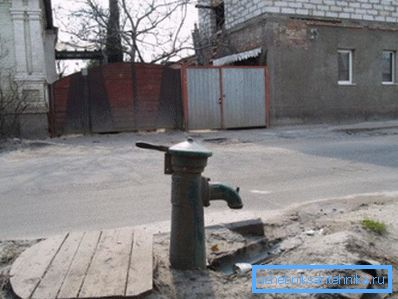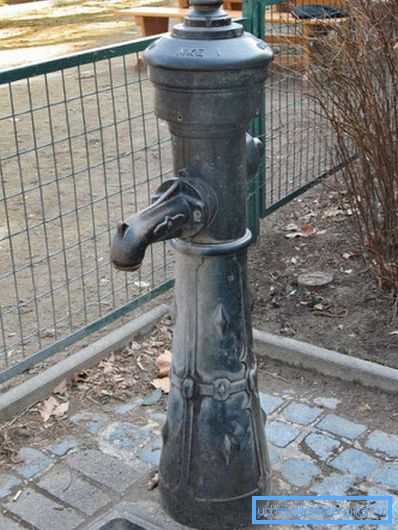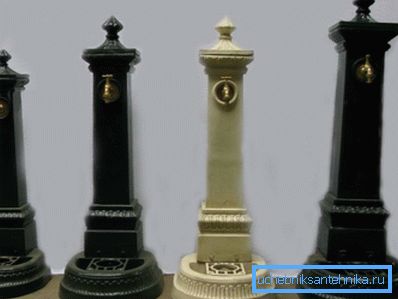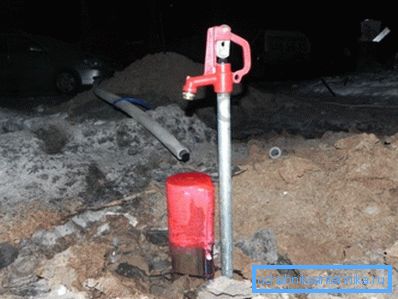Water column for a country house
In this article we will not talk about connecting a gas column to the water supply, and consider the current types of hydrants that can be used to build a cottage or summer house water supply system.
The topic of the article is relevant in relation to construction sites located in close proximity to the centralized water supply network. Operation of the equipment, which will be discussed in this article, allows you to provide water at home, not equipped with plumbing connections.

So, what is the water supply from a column in a private house, and from what components can it be assembled?
Main characteristics and features of the use of hydrants

The water (water) column is a mechanical equipment designed to collect and supply water from the centralized water supply network.
As already mentioned, the equipment is used to provide water to populated areas or individual construction sites that are not equipped with water supply.
Consider the basic requirements and recommendations that should be considered when installing their own hands and the operation of water booths:
- The traditional location of the water column to this day is considered to be the intersection or roadside part of the pavement.
- In accordance with the requirements of state standards, the radius of equipment maintenance should be no more than 100 m.
- When choosing a location for the location of these installations, it is preferable to use the plots on a hill, since in this case it will be easy to ensure natural drainage.
- Installation of the column can be done on a street water line, on a loop-back line or on branches from the main line.
- Installation of equipment on a dead-end line due to the high probability of freezing is advisable only if a constant and impressive flow of water is expected.

Important: In order to avoid freezing in the cold season, modern water intake columns are equipped with a mechanism by which the rest of the water after dialing does not remain in the upper part of the spout, but is drained down the supply pipe to the lower part of the device. In the subsequent use of the device, the drained water is first sucked up by the ejector and sent to the consumer.
Construction features

The design of the device consists of such elements as:
- valve;
- ejector;
- water pipe;
- housing with a movable in the vertical plane of the lever.
The device of a water column owing to operational features differs in durability and durability.

- Housing column is a vertically positioned pipe with an average cross-sectional diameter of 90 mm. The body is made of low carbon steels, which are well tolerated by sudden temperature changes, mechanical loads, etc. The surface of the case can be painted with ordinary paints, the price of which is low, but for long-term operation it is better to choose those devices whose case is covered with powder paint.
- Water pipe (bar) installed inside the case and is responsible for the water supply. To achieve the optimal intensity of water supply, the conditional passage of a water pipe has a diameter of at least 15 mm. After the water supply is stopped, the residues merge to avoid freezing during the cold season.
- Ejector This is a type of jet pump installed in the column housing for pumping out residual water from the rod.
- Valve - part of the intake column in which the ejector is installed. The design of the valve is collapsible, as a result of which, if necessary, you can replace worn seals. The valve, as well as the entire body of the column, is made of strong and durable low carbon steel.
Operational deficiencies of equipment

If anyone who has a simple installation tool can deal with how to connect a gas water heater to the water supply system, then the speakers in question are not so simple.
Consider the most current operational deficiencies of hydrants and try to find the means to eliminate them:
- Poor operation of equipment at low pressure with a high probability of freezing during the cold season. The reason for this phenomenon is a limited lower pressure limit in the water supply.
- The ingress of surface groundwater into the column spout through the ejector is a significant drawback that adversely affects the quality of water received by the consumer. The reason for the penetration of groundwater is improperly installed gasket.
- The need for great effort when opening the check valve. The reason is the resistance of the return spring and the pressure of the water directly on the valve plate. Nothing can be done about this drawback, since these are structural features of equipment that cannot be changed.
- Column freezing in the cold season, despite the presence of an ejector. The reason for freezing is the remainder of a small amount of water in the rod and in the valve.
How to make sure that the water even in a small amount does not remain in the device and does not freeze? First of all, you can try to properly configure the ejector. This is not easy to do, because the pressure in the plumbing system is variable.
In order to completely get rid of the remaining water in the rod, you can drill out the drain hole or loosen the connecting pipe flange, creating a natural drain. Both methods are difficult to implement, and also contradicts the instructions for using the device. Therefore, it is advisable to entrust such work to specialists.
Important: In regions with particularly harsh climatic conditions, a heating cable can be used for normal operation of the speakers, which will keep the average body temperature above 0 ° C.
Conclusion
Modern decorative water columns are not only a decoration of the garden plot, but also an effective opportunity to provide water for a house, garden, vegetable garden, etc. Now that you know what the design of the device is and what its operating instructions are, you can make the right decision about installing such equipment near your villa.
There are questions that need clarification? More useful information can be found by watching the video in this article.